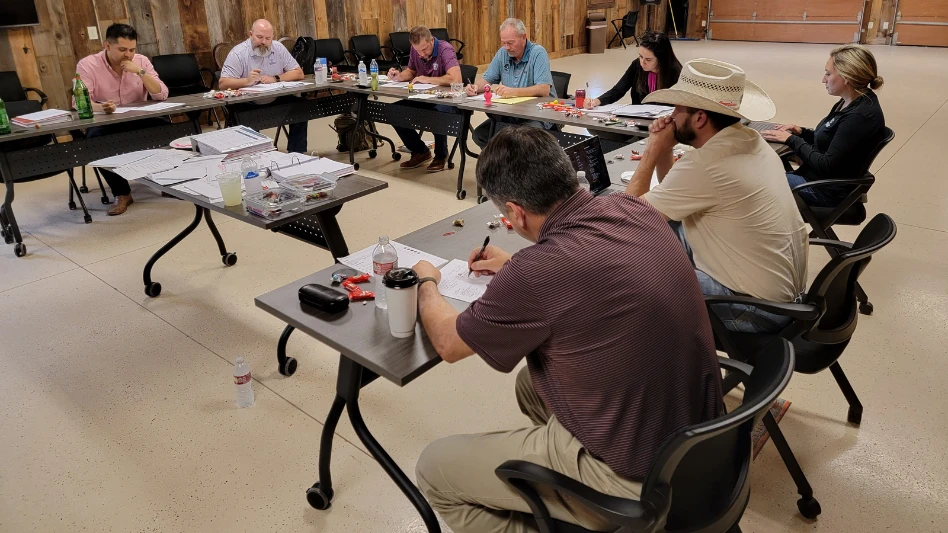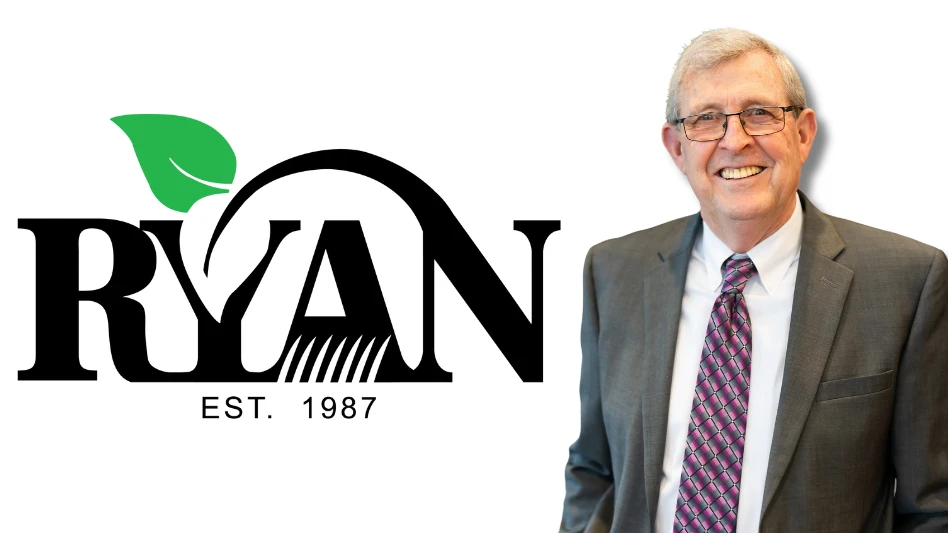 Kurt Bland keeps a bottle cap in his car that’s inscribed with a bit of gritty encouragement: “If you’re going through hell, keep going.”
Kurt Bland keeps a bottle cap in his car that’s inscribed with a bit of gritty encouragement: “If you’re going through hell, keep going.”
That’s Winston Churchill, famous for his refusal to give in. The president of Bland Landscaping in Apex, N.C., says this advice to be bullish and brave reminded him to focus and lead through four years of sweeping change at the firm that resulted in an ownership transfer, organizational realignment, massive personnel shifts and a new technology platform.
“We made decisions based on the company’s present and future needs: How we would position the company to endure the recession and, at the same time, come out stronger than when we went in,” he says.
Recession and Realignment
A sobering budget brings the first changes.
One philosophy underpinned every decision and plan that brothers Kurt and Matt Bland executed when they determined that the $12 million-plus full-service firm their father founded in 1976 was never going to be the same: Align the company to the market.
Kurt remembers the moment he and Matt, senior vice president and CFO, realized the company had to change to accommodate the turbulent market. It was during a plane ride home from a benchmarking meeting with a consultant in Atlanta. The brothers were working on a budget for the coming year, coming off of a record sales season.
In 2008, Bland Landscaping had 225 employees, and the firm had landed two of its largest landscape construction jobs ever. Business was going gangbusters. But the brothers weren’t feeling all that settled.
In fact, Kurt and Matt sat at the airport restaurant during a layover, shared a beer and, then, panic. After 32 years in business, and steady growth, they knew that 2009 was not going to be a repeat. Because something was wrong with the numbers they were repeatedly trying to plug into the next year’s budget.
“We were having a hard time making the budget balance out,” Bland says, relating that the expenses weren’t lining up with the work they expected to come in. “It wasn’t yielding the numbers. Matt and I looked at each other and said, ‘The problem is the economy and what is to come.’ The writing was on the wall that we would have to do something we didn’t want to do.”
That “something” was to consolidate the company’s separate residential and commercial construction divisions, and ultimately close down construction because of the housing market bust. This move pre-empted a chain of monumental business trials that tested whether the Blands had the leadership, the drive, the foresight and the stomach to manage major changes that might have sunk another company.
Bland knew he could not control what was happening to the commercial construction market, to new housing starts, to real estate or his customers’ budgets. He couldn’t control pricing pressure, increasing health insurance expenses and rising labor costs.
“We realized, wow, we are going to have to do something a lot more drastic than what we have done already,” Bland says, who thrives when working in fast-pace crisis mode. It’s a good thing. “We talked about the fact that market conditions may require a completely different organizational structure. And we could control our structure.”
Executive Decisions
A forced merger means job cuts.
The cascade of change at Bland Landscaping really began before the market dropped out in 2008. Four years prior, the Blands’ mother, Nancy, became terminally ill, and their father, Tom, majority owner at the time, planned a yearlong leave of absence that eventually resulted in retirement from the business in 2006. “The retirement brought my brother and me into a faster-than-expected takeover of the company,” Bland says.
Kurt and Matt were equal partners; their father was a majority owner by one share. Their father still maintained ownership in the company until 2011, when the ownership transfer was completed, but he was retired for all intents and purposes.
 In 2008, business was running smoothly and swiftly. Bland Landscaping had a residential new construction department (estate landscaping) that performed renovations and irrigation, and a commercial new construction department.
In 2008, business was running smoothly and swiftly. Bland Landscaping had a residential new construction department (estate landscaping) that performed renovations and irrigation, and a commercial new construction department.
But they felt a sense of urgency going into 2009: Change or choke.
Construction jobs were nearing completion and new work was not on the schedule. “We still had loose ends on projects that were largely completed in 2008 and early 2009, but we had one $900,000 project where the scope got whittled down to $750,000, and just $50,000 left of that work to do,” Bland says, noting a trend of projects getting minimized, then completed – with no backlog waiting.
Profit margins in the Research Triangle area of North Carolina began to erode and customers were asking for price concessions, reduction in scope of work or taking the work out to bid. The most logical move was to consolidate the construction divisions.
“The problem that began with new construction quickly spread into all areas of the economy,” Bland says.
The brothers didn’t know how bad the recession was going to be.
“Matt and I soon became gravely concerned,” Bland continues. “I said, ‘This is not going to be a two-year recession.’ We really had a strong hunch that what was coming was going to be long-lived and painful, so we made the decision at that point to do a forced merger of the different construction elements of the company.”
The company folded its residential and commercial construction divisions into a single unit, and then eventually ceased performing that work entirely.
The company had five department heads running its divisions before the internal merger, and a litany of senior managers that worked under those department heads. But as the divisions rolled up and were phased out, the people managing and working in those areas of the business were either realigned into the new structure, or provided with a severance package.
“When we started looking at the attrition of revenue, we had to start making hard decisions about where to make changes, and the guiding light was to make decisions not based on tenure or history, but based on the company’s present and future needs,” Bland says.
Reality was, Bland Landscaping needed to reorganize and tighten up – align itself with market demand for landscape construction services, which was decreasing.
The merger and initial reduction in force occurred in May 2009 and continued throughout the year.
Meanwhile, the commercial maintenance division began suffering the same economic symptoms as construction. Commercial office sector clients were cutting back. “We were losing construction revenue, so we thought we’d sell more maintenance – but we could not sell the maintenance as fast as we were losing construction,” Bland says.
Maintenance contracts ran the course of the year, but upon renewal the results were not as the Blands had hoped. The company had to continue reducing its labor force, this time in the maintenance division. The company went from a seasonal high of 220 employees in 2008 to about 165 employees in 2010.
It was time for the business to go after different work. In 2010, Bland announced to his people it was the “year of the HOA,” and the company would aggressively pursue these accounts. That move proved a success, and the company got a short repreive.
Burning a Forest
Strong people stay to help rebuild the new company.
Bland recalls reading an article in The Wall Street Journal when Phase I changes at the company were being executed. The writer drew parallels between the life cycles of forests and prairies and those of businesses.
As a naturalist with a degree in agriculture and life sciences, Bland related to these ideas. The theory went something like this: When a business reaches maturity, like a forest, the most effective thing a leader can do is burn that “forest” to the ground and then step back and let the strongest surviving members of the forest grow back stronger, healthier.
“What doesn’t kill the business makes it stronger,” Bland says. “I was sitting in meetings thinking, ‘Who are the strong trees?’ There were trees that had provided a great canopy for the forest for years, but we were not able to guarantee its future for the next 30 years.”
The company was about to burn the forest and grow a stronger environment for sustainable success. So, the Bland brothers could not wait any longer to buy out their father. After all, they expected their organizational efforts to grow the company into a new era. From a strategic and financial perspective, it made sense to transition ownership while the company was at rock bottom.
After the division roll-up and labor reduction came a complete organizational realignment and shifting of employees into roles that suited the company’s new structure. The brothers also began the process of buying out their father on an aggressive schedule.
The time was right – the company was at its all-time lowest value. They got a few unsolicited offers to buy the firm, too. Selling would have been an easy way out.
“But why would we do that now?” the Blands thought. “The business was at its record low as far as all economic indicators would suggest, and we are young and we enjoy this, and we have managers in place that can carry this business into the future and outcompete every one of our competitors, and I believe that wholeheartedly,” Bland says, quickly adding: “There is not a competitor I am scared of.”
Selling was not an option. The brothers continued the transition of ownership process throughout 2011, closing it out before year-end.
A Personal Loss
Amid it all, the Blands lose a dear friend.
At the same time, the company was facing a serious business and personal loss when a key executive and childhood friend became terminally ill. Kyle Martin had run the residential estate gardening division and worked at Bland Landscaping for 17 years. That department became a “shining star” of the company as Bland and team worked to drive it, in a way to honor their friend and colleague.
Bland was restless, engulfed in the transition of ownership, infrastructural change, his friend and key executive’s illness, and the constant market jabs.
“I would wake up in the middle of the night and type out my thoughts, either in an email or note to self,” he says of the stress. “I didn’t know if I would have time to focus on what I was thinking about the next day.” He was working in the business, furiously, as was Matt. And in Bland’s waking moments – and hours – at night, he was working on it.
The week Martin went to hospice care in December 2011, Bland visited him daily and simultaneously worked up a plan with his team to build a landscape at Martin’s family home for Christmas. The company received donations of plant material, pavers, stone and a lighting system, and a team of about 40 people cleared and rebuilt the property, building the patio he had been working on for years.
A week later, Bland delivered Martin’s eulogy.
But before this, during Martin’s final days and an emotionally wrenching time for the Blands and the company, Bland also learned that two key employees had been deceiving the company. The situation was so ugly that Bland can’t talk about it on the record, and he doesn’t explain what happened off the record, either.
“They were being very dishonest to us, their peers and others,” Bland says plainly.
So in 2011, Bland Landscaping said goodbye to a dear friend, parted ways with two key employees that had been dishonest, and completed an ownership change. Then, in January 2012, the company launched its realignment, which impacted every person at the organization.
Decision Time
Realignment puts pressure on everyone.
An old Islamic saying goes like this: “When forced to decide between fever and death, the fever looks like a smart decision.”
2012 called for more fever decisions to restructure the company further, well beyond that initial rollup of the construction division. This put tremendous pressure on management.
In late 2011, Bland had asked his managers to prepare budgets. Then, upon reviewing the unrealistic proposals, he asked for a second round, and then a third. Bland was not getting the numbers he wanted to see from his managers.
The team, Bland decided, had impaired decision-making capabilities because they were personally affected by requests to cut back. “If someone asks you to make a decision that could affect the future of your job, that’s a hard decision to make,” he says.
Since its founding, Bland Landscaping had been organized into departmental silos. This new structure would remove redundancies by forming two key sectors: commercial landscaping and residential estate gardening.
Under the old, traditional model, managers served two masters: sales and operations. And they were spread too thin.
“You could not physically do the job in less than 10 to 12 hours every single day,” Bland says. As the company continued to diversify and expand its HOA business, this grueling schedule would become the norm. And, this scenario was not acceptable or productive for the company and its people.
With the realignment, personnel would be dedicated solely to operations or customer service duties. It was a seismic shift to both employees and clients. The company lost some accounts due to the change. Some employees gave up responsibilities – sometimes grudgingly – to others who were better suited for their roles.
“During that year, every time we put someone in a new role, we’d counsel them and talk to them and collect feedback from the customer, and then we would re-evaluate the decision,” Bland says. “We’d ask, ‘Did we put you in the right role? Did you choose the right role?’”
Throughout the course of 2013, sales were coming back. And by year-end, following the organizational realignment and continued growth of the residential estate gardening sector, the company was 75 percent completed with its transition.
A Platform for Growth
New technology completes the changes.
B land says the company won't ever be 100 percent finished, but one last transition remained. After changing its services, its organizational structure and its ownership, the company introduced a cloud-based technology platform in 2012.
The mobile workforce allows for real-time information gathering and administrative capabilities. No one’s tied to a desk, and, Bland can make better decisions based on future forecasts.
“Between the personnel changes, the structure, the technology platform – and we are still largely a debt-free organization – our balance sheet is stronger than it was when we came into the recession because we made prudent, timely decisions,” Bland says.
The technology allows easier expansion to new facilities, since the systems are all cloud-based. The company can pursue jobs that are historically more competitive because the firm has an operational and overhead cost structure in place to present tight bids.
Today, Bland Landscaping is projecting 2015 gross revenue at $15 million – the highest since the business started almost 40 years ago. Commercial construction work has come back, and the company’s head count fluctuates between 190 and 220 employees, and there are 105 vehicles on the North Carolina roads emblazoned with the family name.
But perhaps what’s most exciting for the Blands is the organization’s energy. People are fired up. Opportunity is within reach for those 200-some people. “There is a really strong buzz around the company right now, and not just for owners and managers, but for foremen and skilled workers alike,” Bland says.
After all this, Bland is stepping back from operations, with a structure and people in place that can take the business forward. Reflecting on the long journey since that discussion with his brother in the airport, the numbers just not adding up, the long, sleepless nights and having to make very tough decisions about which employees to keep and which to let go, Bland, remains humble. “I don’t take any of this for granted,” he says.
Photography by Brian Olson

Explore the September 2014 Issue
Check out more from this issue and find your next story to read.
Latest from Lawn & Landscape
- LMN partners with Attentive.ai
- Get to know the generations working for you
- Addressing addiction in landscaping
- Fairway expands national footprint with 6 acquisitions
- Graze Robotics opens new headquarters in Plano, Texas
- Addiction in the green industry
- Kress earns Sourcewell approval
- The best laid plans





